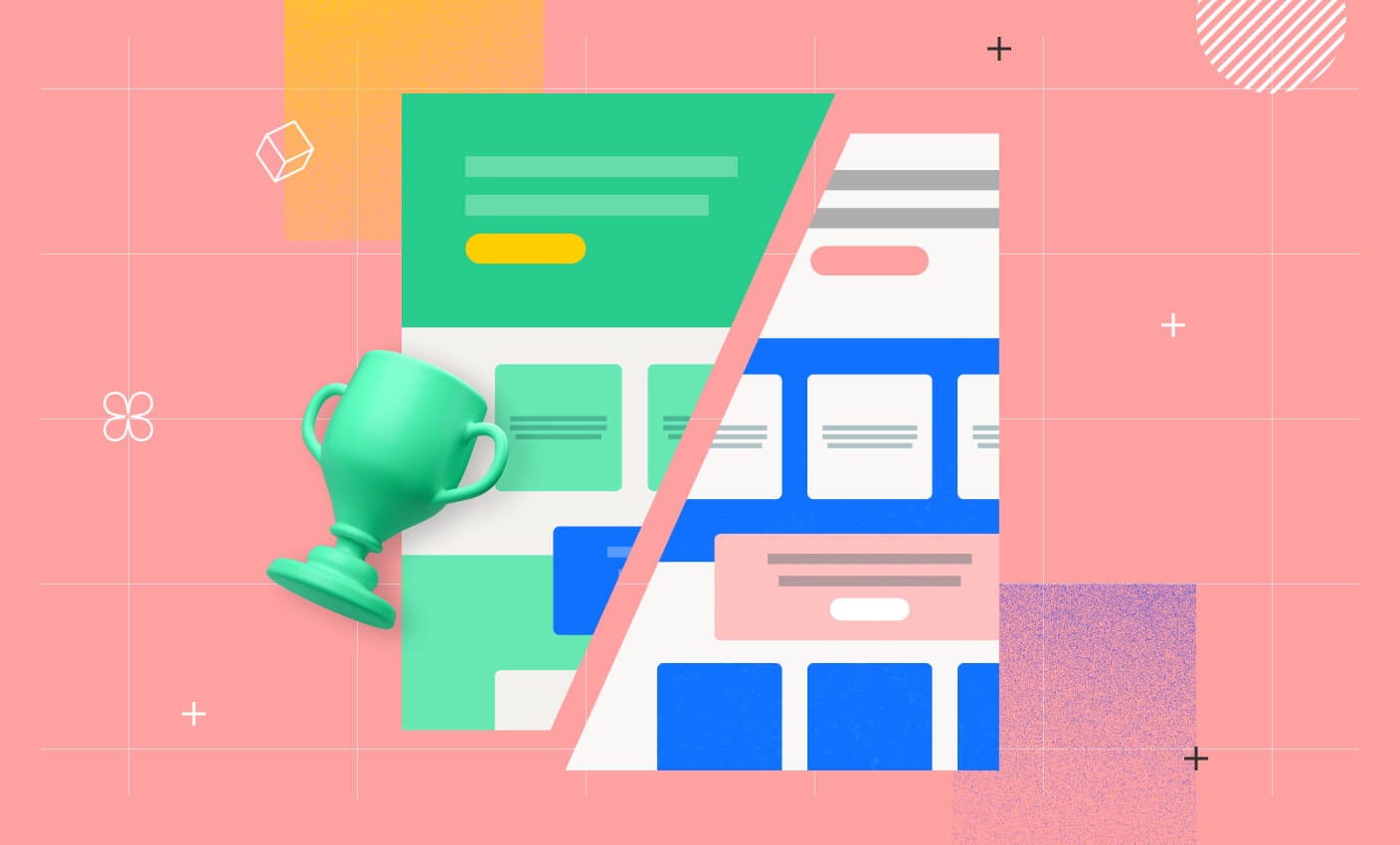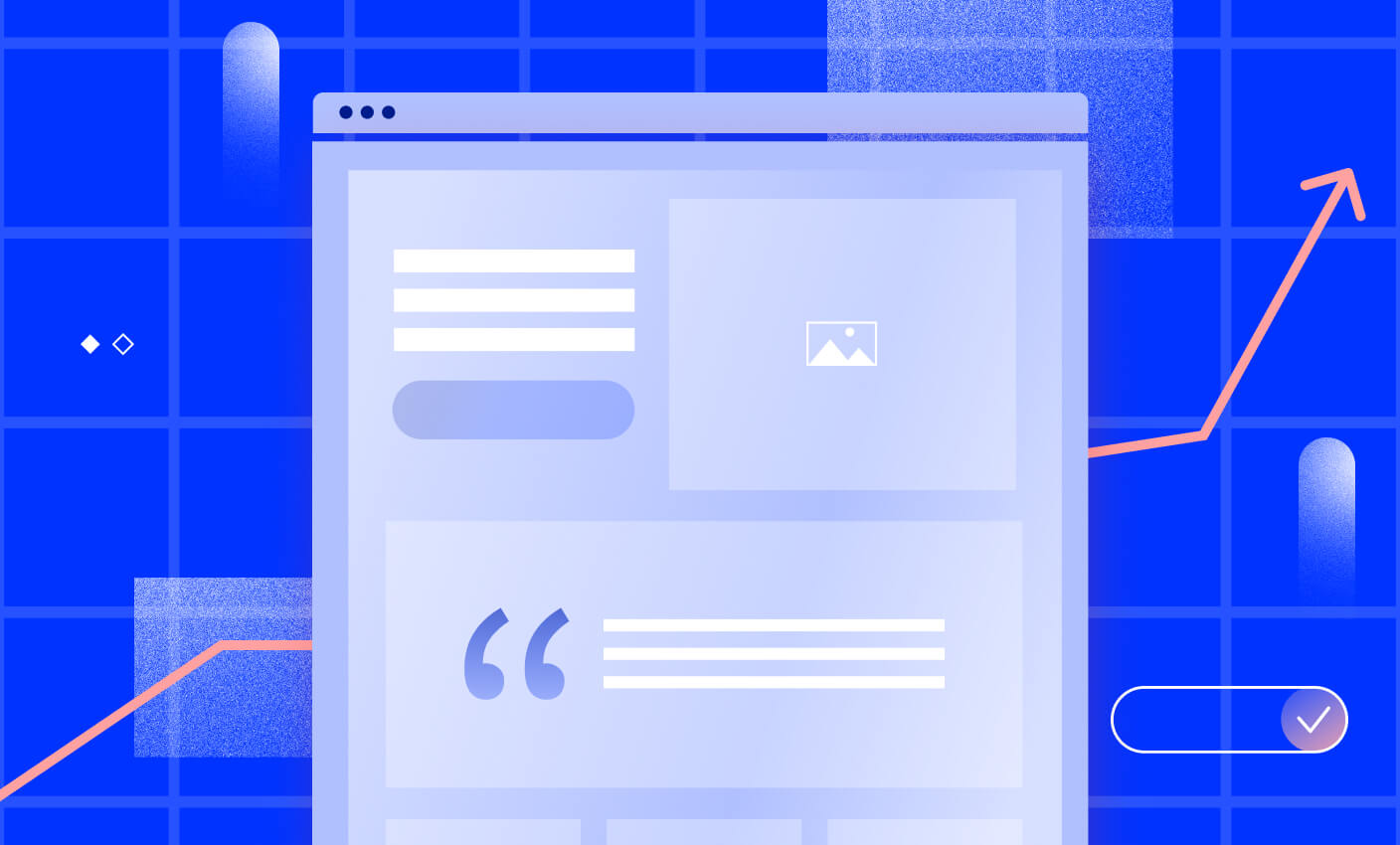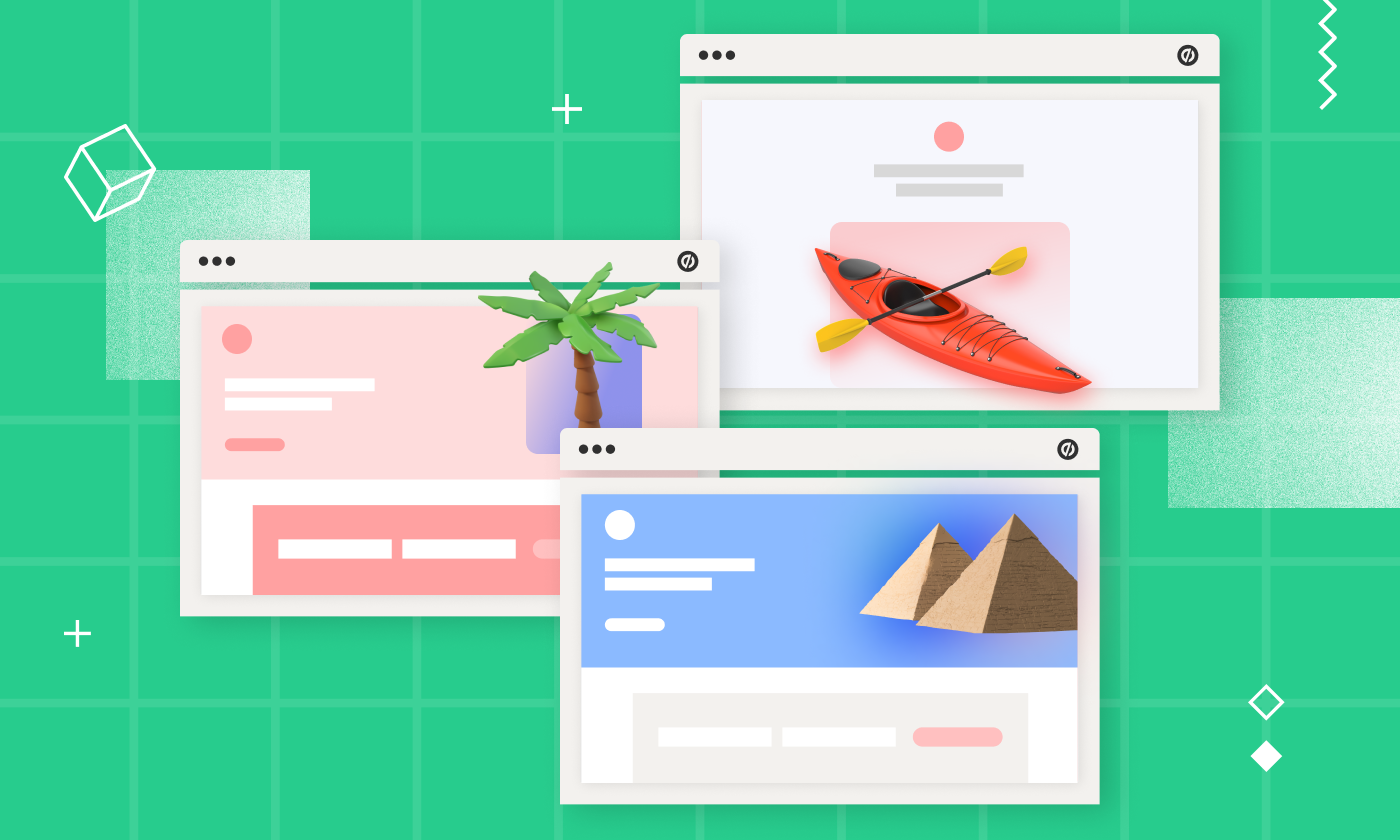Paul Park
Paul is a writer on Unbounce’s content team who lives and breathes storytelling. (It’s like oxygen but with better plotlines!) Ask him what he’s up to at any given moment and you’ll get answers ranging from folding paper dragons (y’know, origami) to catching up on the latest cool tech, and finding other ways to channel his inner geek.
» More blog posts by Paul Park
What is landing page optimization, and why does it matter?
Landing page optimization is the art and science of turning first glances into action (y’know, conversions). It’s all about tweaking and tuning your digital welcome mat so every visitor feels like it’s been rolled out just for them.
This process isn’t just about slapping on a fresh coat of paint. It’s a meticulous method of analyzing, testing, and refining the elements of your landing page to boost the likelihood that a visitor will convert—whether that be signing up, making a purchase, or downloading your latest ebook.
Landing page optimization tools can take many forms, including A/B testing, AI-powered traffic routing, heatmaps, and others. In the case studies below, you’ll see how different marketers choose the best tools for their particular situations.
Why is this optimization odyssey crucial for marketers?
In the bustling online marketplace, your landing page is like a storefront window. If the display doesn’t catch the eye, potential customers will just stroll on by. Optimizing your landing page ensures that once visitors land, they’re greeted with a compelling, persuasive, and user-friendly experience.
It’s about making every second count to reduce bounce rates and boost conversion rates. After all, what’s the point of driving traffic if it just drifts away like a tumbleweed through a ghost town?
Landing page optimization also lets you peek into your audience’s preferences, behaviors, and triggers. This isn’t just about changing button colors or changing layout templates (although those can definitely be part of the process). It’s about crafting an experience so tailored and tempting that clicking “Buy” or “Subscribe” becomes as natural as scrolling through a feed.
For marketers, it’s the closest thing to a mind-reading device, providing insights that fuel smarter, more effective marketing strategies across all channels.
So, roll up your sleeves and dive deep into optimization—because in this game, the best setup wins the most conversions.
10 landing page optimization examples and case studies to spark inspiration
Okay, now let’s explore some examples (most of which were done through Unbounce) that show how marketers hit their goals and achieved greater levels of success through landing page optimization.
1. Going: How a three-word change led to a 104% conversion boost
Travel discount company Going’s business model hinges on giving potential customers a taste of their service through two primary methods: a free plan with limited features and a two-week trial of a premium paid plan.
Historically, Going’s landing page prompted visitors to sign up for the free, limited plan. But the company had a hunch: If potential customers could directly experience the full benefits of the premium plan, they might be more likely to convert to paying members.
To test this theory, Going’s marketing team used Unbounce’s A/B testing tool. They crafted an experiment on the homepage by tweaking the call to action (CTA). The original CTA, “Sign up for free,” was pitted against a new variant: “Trial for free.” This change might seem minor—just three words—but it more directly invited users to experience the full value of Going’s offering without any commitment.
The impact of this simple word swap was nothing short of spectacular. The A/B test revealed a 104% increase in the trial start rate month-over-month. This not only proved Going’s hypothesis but also marked a significant turning point for the company.
“This experiment, as small as it was, legitimately changed the way that we’re able to spend on media,” reported Forrest Schaffer, Going’s Senior Manager of Growth. For the first time, Going’s conversion rate through paid channels surpassed that of organic traffic, marking a massive win for the company’s marketing strategy.
This success story from Going serves as a powerful reminder that the right words can make a world of difference. It underscores the importance of continually testing and refining every element of your landing pages—because you never know which small change could lead to your next big breakthrough.
2. Campaign Monitor: How dynamic verb matching boosted conversions by 31.4%
Campaign Monitor, a San Francisco-based company that simplifies email marketing campaigns, faced a common challenge: increasing the effectiveness of their PPC landing pages.
Their hypothesis? If the copy on a landing page dynamically matched the exact verb used in a visitor’s search query, it could significantly boost the page’s relevance and the likelihood of conversion.
For instance, if someone searched “design on-brand emails,” the word “design” would appear in the headline and CTAs, rather than alternatives like “build” or “create.”
To test this theory, Campaign Monitor set up an experiment using Unbounce’s dynamic text replacement (DTR) feature. This tool allowed them to change the text on the landing page to directly reflect the search terms used by potential customers. The setup involved creating two variants of the landing page to measure the effectiveness of the dynamic text replacement against a control version.
Before launching, they ensured the sample size and test duration were adequate to achieve statistical significance. With a total of 1,274 visitors across both variants over 77 days, they were set to see if dynamically matching the verb from the search query to the landing page content would indeed increase conversions.
The outcome was clear and compelling. After the 77-day period, the variant with the dynamically changed verb saw a remarkable 31.4% increase in conversions, with signups for Campaign Monitor’s software trial significantly outperforming the original. This test not only reached 100% statistical significance but also affirmed the power of aligning landing page copy with user intent.
This example highlights the effectiveness of tailoring content to meet the specific needs and language of potential customers. By matching the landing page verb to the search query, Campaign Monitor made their offer feel more relevant and enticing, leading to an impressive lift in conversions. It’s a powerful reminder that sometimes, the right words are all you need to turn prospects into customers.
3. Love Child Organics: How a shift in visuals and targeting improved results
Aiming to expand their email marketing reach, Love Child Organics faced high costs in acquiring subscribers through their initial coupon offer landing page, which had a conversion rate of 43% and a cost-per-acquisition (CPA) of $2.00.
Banan, the marketing agency hired by Love Child Organics, employed A/B testing on Unbounce to optimize their landing pages. They experimented with different imagery, swapping photos of babies for toddlers, and refined their ad targeting strategies to better align with their audience’s preferences and behaviors.
These are just two of the adorable photos Banan tested to see which performed better on their landing pages.
These strategic changes significantly improved performance. After eight months of optimization, the conversion rate soared to 69% (from 43%) and the CPA decreased to $1.30 (originally $2.00), marking a significant 60% improvement in the conversion rate.
These optimizations not only cut costs but also better positioned the brand for its commerce transition, enabling them to showcase products more effectively through landing pages.
4. Zola: Unlocking more “I do’s” with higher conversions
Zola, a leading online wedding planning and registry service, needed to scale their digital marketing efforts to match their rapid growth and diverse product offerings. Their goal was to enhance user engagement and increase conversions through targeted advertising and personalized landing pages.
Leveraging Unbounce’s landing page builder, Zola’s marketing team developed over 300 landing pages tailored to very specific audience segments. These pages were designed to resonate with different types of visitors, from Pinterest users interested in building wedding websites to couples curious about how their home decor style could influence their registry choices.
They utilized Unbounce’s capabilities to quickly launch and optimize these pages, ensuring a seamless alignment between ads and landing pages.
This strategic approach resulted in a significant boost in efficiency and effectiveness. Zola saw an increase in conversion rates ranging from 5% to 20% across these new landing pages compared to their previous website pages. The insights gained from the highest-performing landing pages were so impactful that they were incorporated into the overall design and structure of Zola’s main homepage, further enhancing their marketing success and user experience.
5. Hotjar: Popping up a way to increase trial signups
Hotjar, known for its heatmaps and behavior analytics tools, faced the challenge of increasing trial signups from their website traffic. They needed a solution that would convert without being obtrusive, maintaining a positive user experience.
They decided to employ a targeted popup strategy on their pricing page. This popup was designed to trigger only for first-time visitors as they showed intent to leave the page. It offered a valuable ebook, effectively using an incentive to encourage visitors to sign up for a trial.
The popup proved to be a game-changer. It achieved a 3% conversion rate, significantly boosting Hotjar’s trial signups by over 60 new users each month. Impressively, 75% of these new signups were from completely new customers. This strategic implementation not only enhanced their conversion rates but also offered insights into effective engagement techniques, demonstrating the power of well-placed, relevant offers.
6. World of Wonder: Using AI to unlock new heights in conversion
World of Wonder, the bustling media company behind RuPaul’s Drag Race, faced a common dilemma: How to optimize their landing pages for better conversion without getting bogged down in complexity.
The team wondered if Smart Traffic, Unbounce’s AI-driven optimization tool, could enhance their campaign landing pages’ effectiveness. Their hypothesis was simple, yet ambitious: Test Smart Traffic on three different campaign landing pages over a four-week period to see if it could boost conversion rates.
Smart Traffic uses AI technology to analyze visitor attributes like location and device to direct them to the most suitable landing page variant, maximizing the likelihood of conversion. For Maggie, a designer at World of Wonder, the appeal was clear. Despite the company’s fast-paced environment, she recognized the potential of Smart Traffic to streamline their efforts. “It’s pretty quick,” Maggie said, “and it’s not like you have to change the whole page.”
With just a few clicks, new variants were created and deployed, leveraging historical conversion data to fine-tune each visitor’s experience. This approach not only addressed user needs more effectively but also allowed the team to remain agile—critical in their fast-moving industry.
The results were nothing short of impressive. Over the test period, World of Wonder witnessed an overall conversion lift of 19.7% across the three tested pages. Some specific page variants even surpassed this average, highlighting the potent impact of targeted, AI-driven optimization.
This experiment not only underscored the effectiveness of Smart Traffic but also demonstrated its ease of integration into existing workflows. Even in an industry where conversion rates hover around 7.9%, using AI to enhance user experience proved to be a game changer.
7. CD Baby: How to regularly hit double-digit conversion rates
CD Baby is an independent music distribution company that gives music artists a platform to release their music to the world while retaining full ownership. (And no, they don’t sell CDs anymore, in case you were wondering. These days it’s all digital.)
CD Baby operates in a niche, yet expansive, market, catering to artists at varying stages of their careers and across diverse geographical locations. The primary challenge was crafting targeted messaging that could resonate across such a fragmented audience, with the aim to boost traffic, lead generation, new accounts, and ultimately, ecommerce revenue.
To address this multifaceted challenge, CD Baby leveraged the power of highly specialized landing pages. These pages allowed the marketing team to have tailored conversations with specific segments of their audience. “Landing pages allow you to diversify and scale your messaging, so you can have custom conversations with specific audiences,” explained Daniel Parscale, marketing specialist at CD Baby.
The real game-changer was the integration of Smart Traffic, which used AI to automatically direct visitors to the most appropriate landing page variant. Each visitor experienced a version of the page that was most likely to appeal to them, whether they were more motivated by direct monetization benefits or social proof.
The application of targeted landing pages combined with Smart Traffic led to staggering results: one of CD Baby’s campaigns has maintained a stable conversion rate of 37.17% over six months, drastically outperforming the industry median conversion rates of 3% for e-commerce and 5.2% for SaaS. This campaign was specifically designed for branded searches, aiming to capture the attention of users already familiar with CD Baby but uncertain if it was the right fit for them.
8. Truckers Report: Steering towards success with higher conversions
Truckers Report needed to revamp their landing page to better serve their community of truck drivers who use the platform to find job opportunities so they worked with CXL to make some improvements.
The existing page was underperforming, as shown by lackluster engagement metrics and conversion rates. CXL’s initial assessments highlighted several areas for improvement: The page wasn’t fully optimized for mobile users, who constituted about 50% of the site’s traffic, and it lacked compelling content that resonated with the users’ needs and desires.
Armed with insights from Google Analytics, SessionCam, and targeted online surveys, they created a more engaging and responsive landing page.
They focused on enhancing usability for mobile users and addressing the visual and textual elements that were falling flat. The stock photo of the generic handshake was replaced with imagery that truck drivers could relate to, and the headline was rewritten to clearly highlight the benefits of joining the Truckers Report community, specifically targeting key driver concerns like pay, benefits, and home time.
They also improved the overall design to make a better first impression while maintaining the page’s usability, which heat maps and user session videos showed was already effective. Importantly, CXL bolstered the page’s credibility by adding testimonials and trust signals to reassure drivers of the legitimacy and value of the opportunities presented.
After six rounds of iterative testing, focusing on refining these elements without dramatically altering the layout, they achieved a conversion rate that was 79.3% better than the original. This significant improvement highlighted the power of responsive design, targeted content, and visual appeal in driving conversions.
The Truckers Report case study underscores that testing is a marathon, not a sprint. It requires patience, persistence, and a willingness to learn from each test. Remember, each round of testing provides valuable insights that can inform future optimizations, making it essential to view these efforts as ongoing campaigns rather than one-off attempts.
9. ClickMechanic: Fine-tuning the journey to optimization
ClickMechanic, a UK-based auto repair marketplace, used customer feedback and heatmap data to optimize their landing pages and drive impressive growth.
They faced two main obstacles in their quest for higher conversions: Potential customers were hesitant to book services due to pricing concerns and a lack of transparency about who would be performing their car repairs. The company needed to identify these barriers and find solutions that would not only encourage bookings but also enhance user trust and satisfaction.
With concrete data in hand, ClickMechanic took strategic steps to address the identified issues.
The team decided to adjust their pricing to be more competitive and aligned with market rates. Moreover, they implemented a feature that allowed customers to see mechanic profiles before booking, fostering a greater sense of trust and control among users.
Informed by heatmap data, ClickMechanic concentrated their redesign efforts above the fold, making sure that the most crucial information and CTAs were immediately visible without scrolling. This targeted redesign not only saved costs on unnecessary modifications but also ensured that the changes would have the maximum impact on the user’s first impression.
Adjusting the pricing structure resulted in a 60% increase in revenue within just two months—a clear indication that they had successfully aligned their offerings with customer expectations. Also, by enhancing transparency around mechanic assignments, they achieved a 10% increase in conversions, proving that trust is a critical component of the customer decision-making process.
The strategic redesign of the landing pages, focusing on optimizing the above-the-fold content, paid off with an additional 15% increase in conversion rates. This approach not only made their landing pages more effective but also more cost-efficient, reducing the need for extensive redesigns and engineering work.
10. Moy Consulting: Blowing the roof off with 5x growth in 6 months
In the competitive world of digital marketing, particularly within niche industries like roofing, achieving high conversion rates can seem like scaling a particularly steep roof (see what we did there?). This was the exact challenge faced by Mats Moy, founder of Moy Consulting, who juggled multiple roles and responsibilities while trying to grow his business in an industry where every click costs a premium.
As a one-man band managing multiple clients and his own marketing, the pressure was on. In the roofing industry, where clicks can cost upwards of $60, maximizing the value of each visitor was crucial. Mats needed a strategy that could not only increase conversions but also manage this without requiring constant hands-on attention, allowing him to focus on expanding his business.
The breakthrough came when Mats decided to shift his business model from solely providing services to educating his clients. He launched a lead generation training course specifically for roofers, teaching them how to effectively use Unbounce landing pages to captivate their local markets. By empowering roofers with the skills to create and optimize their landing pages, Mats enabled them to drive their marketing autonomously.
The real game changer was his strategic use of Unbounce’s AI-powered Smart Traffic. By setting up multiple variants of his registration landing page, Mats could let the AI determine which version performed best for each visitor, eliminating the need for labor-intensive A/B testing.
The impact of this innovative approach was dramatic. Within six months, Mats grew his client base from 15 to over 80 (over 5x growth!). The registration landing page for his training program boasted an 8% conversion rate, and with the help of Smart Traffic, he saw an overall lift of more than 35%. This efficiency allowed Mats to expand his team, bringing on four additional marketers to help manage the increased workload and continue scaling Moy Consulting.
This case study not only highlights the success of using AI and machine learning to enhance landing page performance but also demonstrates the power of educating clients to use these tools themselves. As Mats Moy has shown, giving clients the reins to their digital strategy, with some smart technology to guide them, can lead to exponential growth and sustainable business practices.












![[Unbounce – BOFU] Pricing – V3 – 2024 Unbounce Conversion Rate Optimization CTA banner](https://unbounce.com/photos/Unbounce-BOFU-Pricing-V3-2024.jpg)





